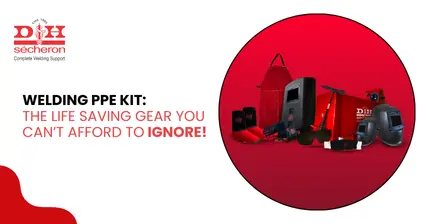A general perception is that welding iron is highly difficult as it has presence of carbon content at high levels. The carbon has a tendency to penetrate either into the weld metal, the heat-affected area adjacent to the weld metal, or both. When this happens, the end result is hardness or brittleness. This also leads to cracking after the weld. Hence, welders define weldability of cast iron as low.
Well, cast iron welding is challenging indeed, but not impossible subject to some conditions.
Types of Cast Iron Welding Rod
The casting welding rod choice depends on one welder to another. However, the most commonly used ones are 99% nickel rods, 55% nickel rods and steel rods. The casting welding rod specification varies according to welding current, wire chemistry and other parameters if applicable.
Steps to Cast Iron Welding
There are four essential steps to do weld cast iron:
Determine which allow needs to be used – grey cast iron, white cast iron, ductile/nodular, malleable iron.
Clean the casting meticulously – remove all surface materials such as paint, grease, oil, etc.
Choose a pre-heat temperature – preheating before welding is done to avoid cracks.
Choose the right welding technique – it depends on the suitability of the cast iron alloy that is being welded.
As far as welding techniques of cast iron are concerned, it can be done through Metal Inert Gas (MIG), Tungsten Inert Gas (TIG), Oxy Acetylene and braze welding. However, these techniques involve many challenges and require precautions. Hence, experts believe that Manual Metal Arc (MMA) which is also known as stick welding or shielded metal arc welding might be a better and safe welding testing method initially.
Some experts also recommend a radiographic test for welding cast iron. It is a non-destructive testing technique that helps to detect discontinuities in the welded structures before destroying them.
Bead welding is another method preferred by welders. In this method, small beads of 1” are used at a lower heat to avoid cracking. The welders peen the bead while it is hot with the help of a round-nosed peen hammer.
Heat Vs No Heat
Preheating is recommended for cast iron welding. However, some welders also keep it cool. Here, cool means low temperature without being too cold. It is advisable to stick to only one way – either preheating or cooling. If it is changed in the middle of the process, then welding will not yield desired results.
Cast iron welding requires practice, patience and experience. Keep the above guidelines in mind to get it right.
11 May 2025 | Welding
An In-Depth Exploration of Low-Alloy Steel: Your Comprehensive Guide
11 May 2025 | Welding
Nagpur - Bori - Tuljapur Road MSH-3 in Yavatmal District (Maharashtra)
11 May 2025 | Welding
Guidelines to Understand Gas Welding: Applications, Advantages & Disadvantages
11 May 2025 | Welding
3 Tips for Finding the Best Mild Steel Electrode for Your Application
11 May 2025 | Welding
How to Select the Right Welding Filler Wires for Stainless Steel Welding?
11 May 2025 | Welding
Building the Narendra Modi Stadium with Norma V and Autotherme-1 Electrodes
11 May 2025 | Welding
Low Alloy Steel Welding in a (PEB) Pre Engineered Building Structure
11 May 2025 | Welding
Welding Rods: Different Types and Tips for Properly Storing and Handling
11 May 2025 | Welding
Tips for Flawless Welds with Stainless Steel Electrodes: Pros and Cons
11 May 2025 | Welding
Exploring Applications and Benefits of Stainless Steel Welding Electrodes
11 May 2025 | Welding
Welding Basics: Joining Metals with Heat and Pressure - A Beginners Guide
11 May 2025 | Welding
Distinguishing Low-Alloy Steel from High-Alloy Steel: Understanding the Variations
11 May 2025 | Welding
Hard Facing Wire - Understanding the Process and Achieving Optimal Result
11 May 2025 | Welding
Exploring the Advantages of Stainless Steel Electrodes in Welding Applications
11 May 2025 | Welding
Weathering Steel vs. Traditional Steel: A Comparative Analysis of Performance
11 May 2025 | Welding
Choosing the Right Welding Rod: Why 6013 Electrodes Might Be Your Ideal Option
11 May 2025 | Welding
Why 7018 Electrodes Are Preferred for High-Strength Welds in Pipeline Construction
11 May 2025 | Welding
Filler Wire vs. Stainless Steel Filler Wire: Understanding the Key Differences
11 May 2025 | Welding
Exploring the Impact of Filler Material on Welding Quality and Durability
11 May 2025 | Welding
Choosing the Right Cast Iron Electrode for Different Welding Projects
11 May 2025 | Welding
Top Advantages of Cast Iron Electrodes for Industrial Welding Applications
11 May 2025 | Welding
Key Benefits and Challenges of Using TIG Welding in Industrial Projects
11 May 2025 | Welding
5 Reasons Why 7018 Electrode is the Gold Standard for Welding Professionals
11 May 2025 | Welding
Top 5 Advantages of Flux Cored Arc Welding for Heavy-Duty Applications.png)
11 May 2025 | Welding
Lotherme-601: A Game-Changer for Restoring Shoulder Pins in Heavy Machinery
11 May 2025 | Welding
How D&H Sécheron Helped Repair a Rotary Kiln’s Cooler Section with LoTherme 352
11 May 2025 | Welding
Piston Repair for Mining Industry: Cost-Effective Solutions with LoTherme 468.webp)






.jpg)







































.jpg)
.jpg)

.jpg)

.jpg)





.jpg)
.jpg)
.jpg)



.webp)
.jpg)
.jpg)
.webp)
.jpg)






















.png)



.webp)

.webp)
.webp)



